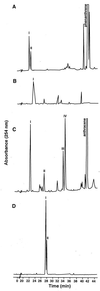Degradation of phenanthrene and anthracene by cell suspensions of Mycobacterium sp. strain PYR-1
- PMID: 11282593
- PMCID: PMC92757
- DOI: 10.1128/AEM.67.4.1476-1483.2001
Degradation of phenanthrene and anthracene by cell suspensions of Mycobacterium sp. strain PYR-1
Abstract
Cultures of Mycobacterium sp. strain PYR-1 were dosed with anthracene or phenanthrene and after 14 days of incubation had degraded 92 and 90% of the added anthracene and phenanthrene, respectively. The metabolites were extracted and identified by UV-visible light absorption, high-pressure liquid chromatography retention times, mass spectrometry, (1)H and (13)C nuclear magnetic resonance spectrometry, and comparison to authentic compounds and literature data. Neutral-pH ethyl acetate extracts from anthracene-incubated cells showed four metabolites, identified as cis-1,2-dihydroxy-1,2-dihydroanthracene, 6,7-benzocoumarin, 1-methoxy-2-hydroxyanthracene, and 9,10-anthraquinone. A novel anthracene ring fission product was isolated from acidified culture media and was identified as 3-(2-carboxyvinyl)naphthalene-2-carboxylic acid. 6,7-Benzocoumarin was also found in that extract. When Mycobacterium sp. strain PYR-1 was grown in the presence of phenanthrene, three neutral metabolites were identified as cis- and trans-9,10-dihydroxy-9,10-dihydrophenanthrene and cis-3,4-dihydroxy-3,4-dihydrophenanthrene. Phenanthrene ring fission products, isolated from acid extracts, were identified as 2,2'-diphenic acid, 1-hydroxynaphthoic acid, and phthalic acid. The data point to the existence, next to already known routes for both gram-negative and gram-positive bacteria, of alternative pathways that might be due to the presence of different dioxygenases or to a relaxed specificity of the same dioxygenase for initial attack on polycyclic aromatic hydrocarbons.
Figures




Similar articles
-
Degradation of phenanthrene and anthracene by Nocardia otitidiscaviarum strain TSH1, a moderately thermophilic bacterium.J Appl Microbiol. 2008 Aug;105(2):398-406. doi: 10.1111/j.1365-2672.2008.03753.x. Epub 2008 Feb 29. J Appl Microbiol. 2008. PMID: 18312570
-
Degradation of benz[a]anthracene by Mycobacterium vanbaalenii strain PYR-1.Biodegradation. 2005 Dec;16(6):513-26. doi: 10.1007/s10532-004-7217-1. Biodegradation. 2005. PMID: 15865344
-
Cometabolic oxidation of phenanthrene to phenanthrene trans-9,10-dihydrodiol by Mycobacterium strain S1 growing on anthracene in the presence of phenanthrene.Can J Microbiol. 1999 May;45(5):369-76. Can J Microbiol. 1999. PMID: 10446712
-
Effects of pH on the degradation of phenanthrene and pyrene by Mycobacterium vanbaalenii PYR-1.Appl Microbiol Biotechnol. 2005 Apr;67(2):275-85. doi: 10.1007/s00253-004-1796-y. Epub 2004 Dec 9. Appl Microbiol Biotechnol. 2005. PMID: 15592827
-
Metabolism of anthracene by a Rhodococcus species.FEMS Microbiol Lett. 2001 Oct 16;204(1):205-11. doi: 10.1111/j.1574-6968.2001.tb10886.x. FEMS Microbiol Lett. 2001. PMID: 11682202
Cited by
-
Current State of Knowledge in Microbial Degradation of Polycyclic Aromatic Hydrocarbons (PAHs): A Review.Front Microbiol. 2016 Aug 31;7:1369. doi: 10.3389/fmicb.2016.01369. eCollection 2016. Front Microbiol. 2016. PMID: 27630626 Free PMC article. Review.
-
Bioremediation of polyaromatic hydrocarbons (PAHs) using rhizosphere technology.Braz J Microbiol. 2015 Mar 1;46(1):7-21. doi: 10.1590/S1517-838246120131354. eCollection 2015 Mar. Braz J Microbiol. 2015. PMID: 26221084 Free PMC article. Review.
-
Biodegradation of anthracene by a novel actinomycete, Microbacterium sp. isolated from tropical hydrocarbon-contaminated soil.World J Microbiol Biotechnol. 2014 Jan;30(1):335-41. doi: 10.1007/s11274-013-1437-7. Epub 2013 Jul 24. World J Microbiol Biotechnol. 2014. PMID: 23881542
-
Multi-Omic Profiling of a Newly Isolated Oxy-PAH Degrading Specialist from PAH-Contaminated Soil Reveals Bacterial Mechanisms to Mitigate the Risk Posed by Polar Transformation Products.Environ Sci Technol. 2023 Jan 10;57(1):139-149. doi: 10.1021/acs.est.2c05485. Epub 2022 Dec 14. Environ Sci Technol. 2023. PMID: 36516361 Free PMC article.
-
A polyomic approach to elucidate the fluoranthene-degradative pathway in Mycobacterium vanbaalenii PYR-1.J Bacteriol. 2007 Jul;189(13):4635-47. doi: 10.1128/JB.00128-07. Epub 2007 Apr 20. J Bacteriol. 2007. PMID: 17449607 Free PMC article.
References
-
- Akhtar N M, Boyd D R, Thompson M J, Koreeda M, Gibson D T, Mahadevan V, Jerina D M. Absolute stereochemistry of the dihydroanthracene-cis- and trans-1,2-diols produced from anthracene by mammals and bacteria. J Chem Soc Perkin Trans I. 1975;1:2506–2511. - PubMed
-
- Bouchez M, Blanchet D, Vandecastelle J P. Degradation of polycyclic aromatic hydrocarbons by pure strains and by defined strain associations: inhibition phenomena and cometabolism. Appl Microbiol Biotechnol. 1995;43:156–164. - PubMed
Publication types
MeSH terms
Substances
LinkOut - more resources
Full Text Sources

